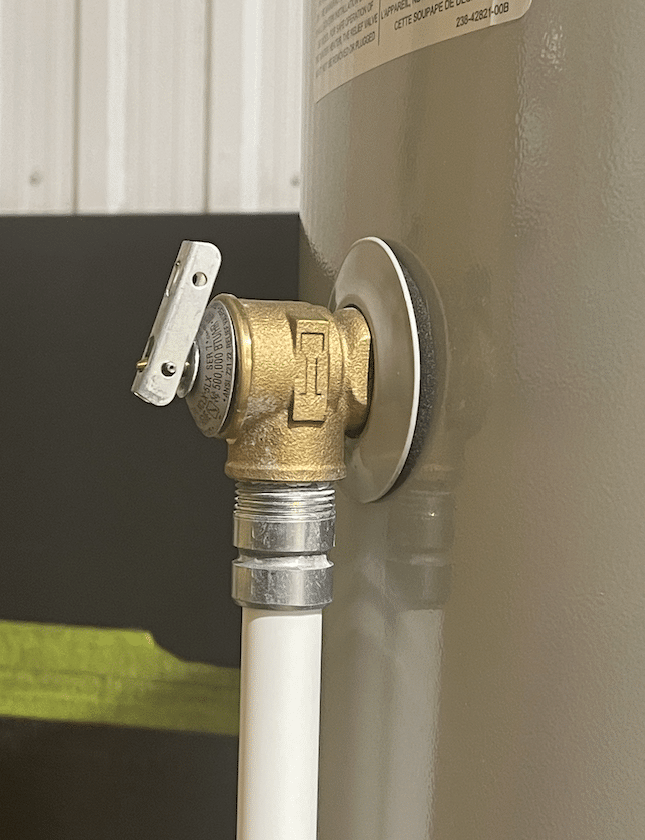Water Heater Pressure Relief Valve : 5 Things You Should Know

If you’ve been having issues with your water heater recently, this article is for you! You might find that you’re paying high energy bills, not getting access to hot water when you want it, or your water pressure is low. This can be frustrating, but what’s the cause? You might be having a problem with the water heater pressure relief valve.
Fortunately, by understanding how relief valves work, you can solve whatever problem you’re having with the one on your water heater. In this article, we’ll review everything you should know about this valve.
Finally, you can get hot water at the right pressure again, enjoying your morning shower like you used to. Read on to learn more.
What Is a Water Heater Pressure Relief Valve?
A water heater pressure relief valve, also referred to as a T&P valve, pressure relief valve, or water heater temperature valve is a safety feature that you can find on any water heater. The reason it’s there is to keep you safe in case the water pressure is too high.
Without this safety feature, your water heater could end up breaking. You could potentially end up with burns if the high water pressure is dangerously high.
This valve also ensures that there aren’t any leaks in your water heater, which would lead to low water pressure when you want to use it to wash the dishes or take a shower.
How Does a Water Heater Pressure Relief Valve Work?
The water heater pressure valve is in place so that it can relieve excess pressure and temperature in a water heater if either of these is too high. Because this everyday appliance is a closed system, thermal expansion occurs in water heaters.
Here’s how it works. Whether your water heater is heated by electric heating elements or a gas burner, both the metal tank and the water inside expand when the hot water temperature is somewhere between 120 and 140 degrees.
However, when the temperature is 210 degrees—or the pressure is 150 psi (pounds per square inch)—t his is far too much pressure and heat in the water heater tank. If it’s the case, you should change your hot water heater temperature or verify your heater thermostat.
If your valve is working, this is when it will open. This releases steam and hot water from the discharge tube, making your water heater operate safely again.





T&P valve… why does it leak?
A water heater pressure relief valve, also referred to as a T&P valve, or water heater temperature valve is a safety feature that you can find on all water heaters. The reason it’s there is to keep you safe in case the water pressure gets too high.
Two of the reasons are that there is sediment or dirt trapped inside the relief port or it is corroded and leaks.
To avoid draining the hot water heater or replacing the valve every so often, install the Corro-Protec powered anode to solve those two issues.
Where Is the Water Heater Pressure Relief Valve?
If you’ve been noticing any issues with your water heater pressure relief valve, then you need to know where it is on your water heater. Usually, you can find it on the top or side of this appliance. The valve connects to a plastic or metal discharge tube that runs down the side of the tank.
The water heater pressure is already installed when you receive your water heater (or buy a home that has one already). It’s actually welded onto the tank; you’ll see a threaded inlet where it is.
You can’t replace or remove it. The valve itself has been screwed into the threaded inlet.
This is for safety reasons. Everything has been done according to standards that have been mandated by plumbing codes. So if you’re having any issues with the valve, you’ll have to call a professional to have it fixed.
This said, if you’re only having issues with the discharge tube, this is easy to replace. You won’t have to drain your water heater, and you can deal with it yourself.
This said, considering that there might be other issues causing discharge tube problems—issues connected to high water pressure or temperature—it’s safest to have a professional deal with this too.
Testing Relief Valves
If you suspect there’s a problem with your water heater pressure relief valve, you can do a test. This is actually a good idea if you don’t have any problems at all, as this type of maintenance will protect your water heater—and yourself.
Remember before you do the testing to change into closed-toed shoes so that you can avoid scalding.
To get started, identify where the relief valve shut off is. Usually, you can find it upon the cold water feed, which is on top of the water tank, on the right side where the inlet is.
Once you’ve done this, take a look at the discharge tube to make sure that it’s attached firmly. Then, take a bucket and put it under the discharge tube.
Now, pull the metal lever of the valve slightly, so that a small amount of the water—a quarter cup or so—discharges into the bucket.
Finally, release the level so that it quickly snaps into the original position. If it doesn’t snap quickly into this original position, then your water heater valve isn’t working and needs to be replaced.
Fixing Your Water Heater Pressure Relief Valve
When your water heater pressure relief valve isn’t functioning properly, it’s usually for one of two reasons. It either sticks so that it doesn’t properly open or close, or it has a leak, which means that it’s continually dripping, lowering your water pressure.
Fixing a Sticky Valve
If your valve is sticky, then it becomes stuck in a closed (downward) or open (extended position). If it’s closed, then the valve won’t be able to relieve the heat or pressure that builds up in the closed water heater system. There could be a rupture as a result.
If it’s open, on the other hand, then it will continuously leak water, which could end up flooding your home.
Sometimes, you can easily fix this problem by opening and closing the valve lever a few times. However, if it continues to stick, then you’ll need to replace it.
Fixing a Pressure Relief Valve Leaking
Your water heater is leaking? Make sure that it doesn’t come from the valve before replacing it. If your pressure relief valve is leaking, then this may be because it isn’t seated properly in the tank’s threaded opening. This is quite a common issue if you’ve recently replaced your old valve with a new one.
To fix this issue with this cause, you have to take several steps.
- First, shut off your water heater. Wait for it to cool completely. Then, remove the valve and rethread it into the water tank opening.
- Another reason the valve could be leaking is that there is sediment or dirt trapped inside the relief port.
- To fix the leaks in valve issue, pull back the metal spring valve lever, after which you’ll discharge water that falls into the bucket.
- If the lever snaps into its original position and it’s still leaking, you need to turn off the gas valve by turning it to the off position. Then, shut the water off so you can replace the valve safely.
A Note on Safety
If a water pressure issue is what is causing the water heater pressure relief valve to not work, then it might be dangerous for you to change the valve yourself. Generally speaking, it’s a good idea to hire a professional to protect yourself.
Blog
What Causes Too Much Pressure in a Hot Water Heater?
It’s important to maintain the correct pressure in a hot water heater for efficient performance and safety. But what happens when the pressure gets too […]
Cloudy Hot Water? Fix It In 15 Minutes!
Why is my Hot Water Cloudy? Have you ever been in this situation? You turn on the hot water, and water splashes around and the […]


